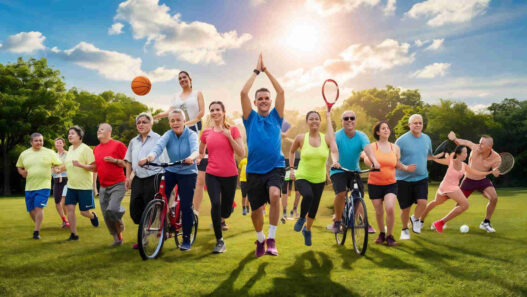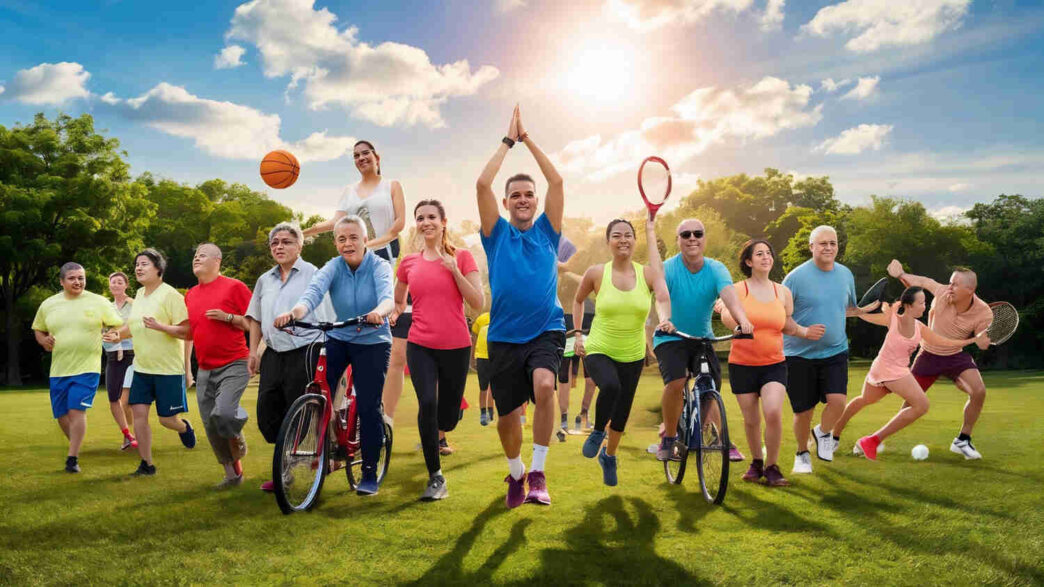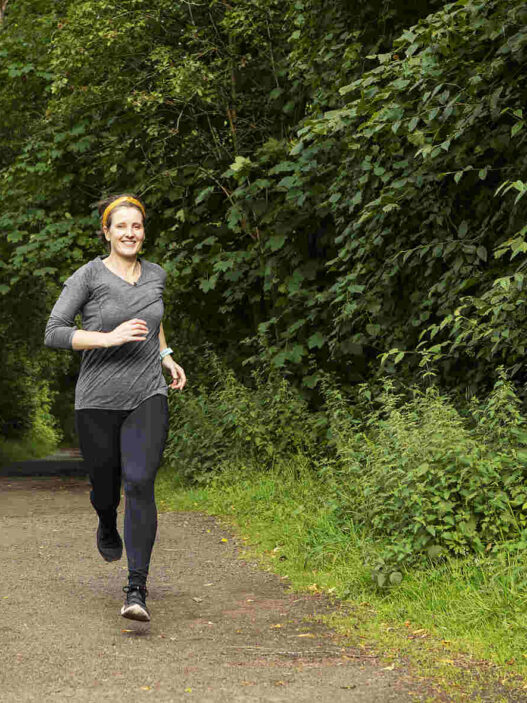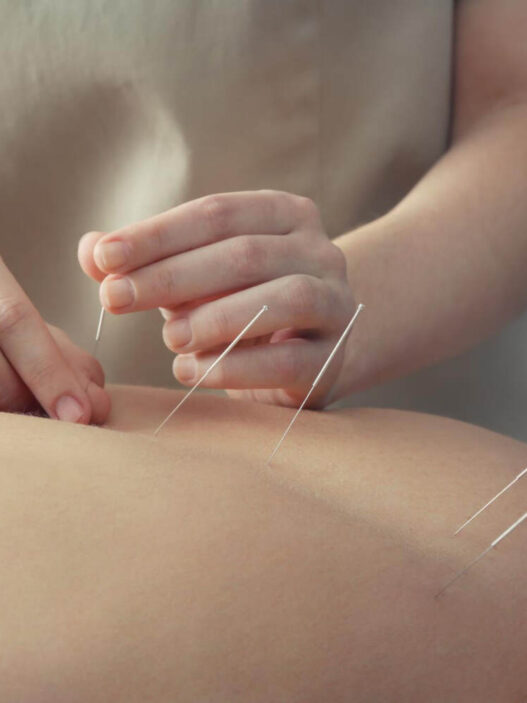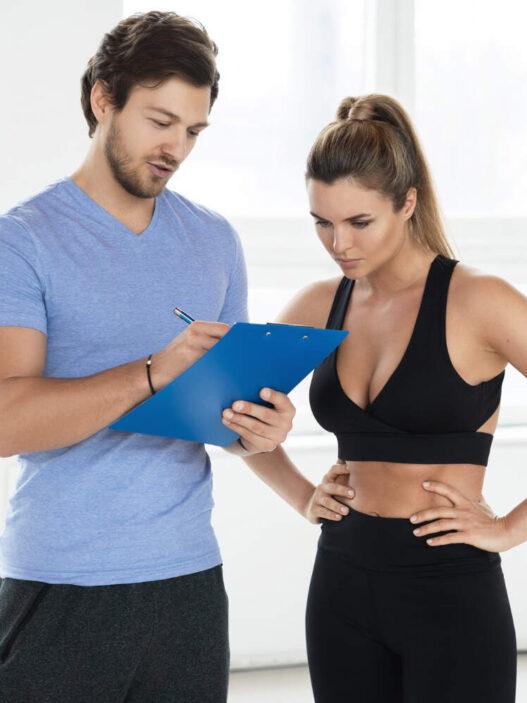Here are the types of physical activity you can do to stay active and for long-term benefits – aerobics, strength training, flexibility, balance, and indoor & outdoor activities. How to incorporate physical activity into your daily life?
Introduction
Did you know that most American adults are physically inactive which hinders their physical and mental health? Physical activity is one activity that reduces your chances of some physical health challenges, decreases the incidence of the major causes of death, and improves your quality of life over time.
According to the data collected by the National Health Interview Survey (NHIS) in 2020, about 24.2% of adults aged 18 years and over met the physical activity guidelines for Americans for both aerobics and muscle-strengthening activities. (1)
Men fulfilled the physical activity recommendation at a higher rate (28.3%) than women (20.4%), and it dropped with age for both men and women. Also, the CDC (Centers for Disease Control and Prevention) through its Active People, Healthy Nation initiative put up an initiative to ensure it’s safe, easier, and more convenient for about 27 million Americans to be active by 2027 in order to improve their quality of life and reduce the cost of health care.(2)
The major concern of most inactive Americans is an issue that may include lack of strength and mobility, increased risk of falls and accidents, weight gain, poor posture, depression, anxiety, and cognitive decline. You need to be physically active daily to avoid the side effects of being inactive.
In this blog post, I will share the benefits and effective ways to include physical activity in your busy daily routine.
What are the long-term benefits of physical activity?
Improves Your Heart Health
Stay physically active; it’s good for your heart. The muscles around your heart become stronger as you engage in moderate or high-intensity workouts. This enables your heart to pump oxygenated blood to other parts of the body effectively.
Engaging in regular physical activity reduces your risk of heart diseases or conditions like high blood pressure, high cholesterol, obesity, or high blood sugar. Most inactive people are at risk of some or many other deadly heart conditions.
Strengthens Your Bones and Muscles
Movement is aided by bones, muscles, and joints. Imagine having issues with any of these; movement could become difficult. The more you age, the more they begin to gradually lose their strength due to usage over the years. Regular physical activity is one effective way to ensure they don’t deteriorate quickly as you age. Physical activities like hiking, lifting, jogging, or dancing are muscle-strengthening activities you can try out one of these days.
Help Manage You Weight
Being physically active helps keep your weight in check by burning excess body fat. Your body burns calories as you engage in any physical activity.(3) You begin to gain weight if your calorie intake is higher than what you are burning off daily. So the best way to burn off the excess calories is to stay physically engaged. You could engage in moderate or high-intensity workouts to keep the excess weight off.
Prevent Frequent Falls
When you start falling frequently, this could be a result of weakness in your muscles and bones. Older adults usually experience weakness of the muscles and bones in the leg due to wear and tear that opens them to frequent falls.
But you need not worry because you can prevent frequent falls by engaging in physical activities that strengthen, improve your physical function, and help you with your day-to-day activities.
You can engage in bone and muscle-strengthening exercises, aerobics, balance training, or use the stairs more often.
Help Manage Chronic Health Conditions
Regular physical activities like jogging or aerobics are known to help manage certain existing health conditions and disabilities. For example, being physically active can help reduce the pain of people living with arthritis or back pain.
If you are suffering from one non-communicable disease or another like stroke, depression, cardiovascular diseases, type 2 diabetes, etc., get active to improve your chances of survival and better manage your health conditions.(4) Your risk of death from these health conditions is reduced if you are physically active.
Boost Your Energy Levels and Makes You Feel Good
This might sound strange, considering the amount of energy expended during any physical activity. Well, it is true. Have you noticed that you regain your energy after expending it doing physical activities?
Are you wondering why this is so? Let me explain.
While exercising, hormones in your brain called endorphins are released, making you feel good and energized to help you push on. The endorphin hormones are also released to relieve pain, reduce stress, boost mood, and give an overall sense of well-being from exercising.
Types of Physical Activities You Can Do To Stay Active
Aerobics
Aerobics is a fun activity that involves continuous and rhythmic movement. These movements increase your breathing and heart rate, strengthening your cardiovascular system in the process. Aerobics is an activity that’s suitable for people of different fitness levels. This means you don’t need to be in great shape before you engage in aerobics.
Types of aerobics you can engage in include:
● Dance Aerobics
● Water Aerobics
● Cardio-kickboxing
● Walking
● Running
● Biking
● Swimming
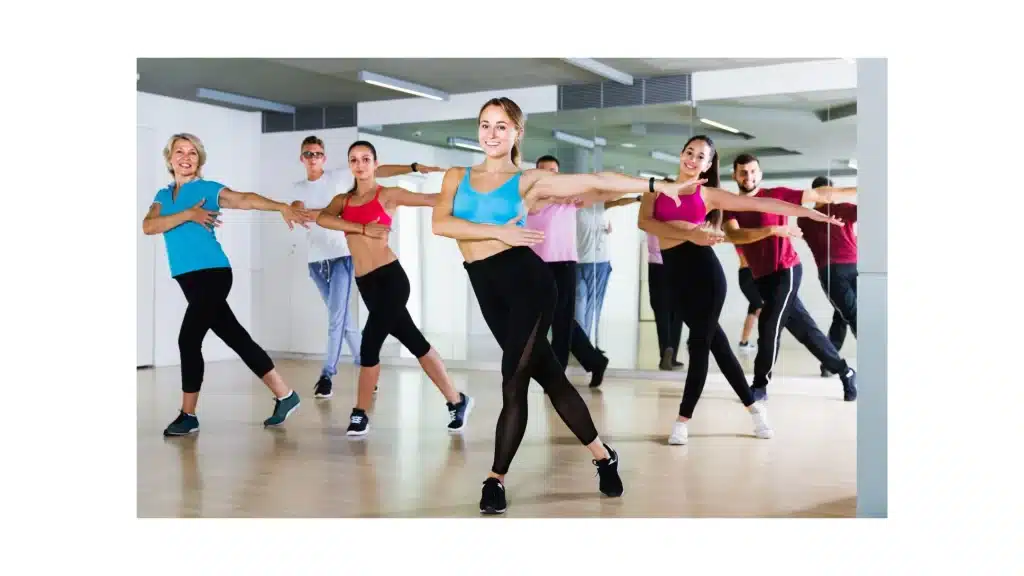
Strength Training Activity
This form of activity involves the building of muscle mass. It involves resistance against muscle contraction to aid muscle growth, development, strength, endurance, and overall fitness.
Here are some common types of strength-training activities:
● Resistance band training
● Calisthenics
● Plyometrics
● Crossfire
● Powerlifting
● Bodyweight exercises
Flexibility Activity
The flexibility activity focuses on and enhances the flexibility of your joints and muscles, which helps prevent muscle injuries and tensions. This form of activity aids the mobility of your joints, which could prevent you from falling.
There are several types of flexibility activities you can indulge in, namely:
● Static or Dynamic stretching
● Yoga
● Pilates
● Tai chi
● Ballistic stretching
● Active stretching
Balance Activity
The aim of this activity is to help improve your balance, stability, and control of your body. Balanced activity enables you to stay physically active and is good for people of all fitness levels. The elderly will enjoy this activity because it reduces their risk of frequent falls.
Balance activities are of various kinds, namely:
● Yoga
● Tai Chi
● Dancing
● Standing on one feet exercise
Indoor Activities
Indoor activities are done in an enclosed space or building that is suitable for any weather, and they are available all year round. Here are some common indoor physical activities you can engage in:
● Basketball
● Running or jogging on a treadmill
● Stationary bike
● Volleyball
● Table Tennis (Ping pong)
● Badminton
● Indoor Swimming
● Indoor Climbing
Outdoor Activities
As the name implies, these activities are done outside when the weather is fine (summer). This activity is suitable for all ages, and it’s a way to behold and enjoy what nature has to offer—sunshine and fresh air.
Below are the types of outdoor activities you can enjoy in the summer:
● Jogging
● Brisk walking
● Biking
● Running
● Walking
● Hiking
● Swimming
● Rock climbing
You can choose from any of the various types of physical activities listed above to get active again. Go for anyone that suits you, and ensure you don’t relent.
How to incorporate physical activity into your daily activity?
Start small
If you are new to this experience, you should start slowly and gradually to enable you to build your resistance and strength levels.
That said, the recommendation for most adults is to reach 150 – 300 minutes of moderate exercise per week. That means you can reach that by doing 30 – 60 minutes of moderate physical activity 5 times a week. If you know you can’t spare 30 minutes of your busy schedule, you can break it into 15 minutes at 2 intervals in a day to stay active.
Engage in activities you enjoy doing
It’s easier to stick to an activity you enjoy doing. Imagine doing what you hate doing every day; it becomes boring, and sooner or later you will lack the motivation to continue.
Identifying activities you love and incorporating them into your routine can be fun. For example, if you love cycling, taking photographs of scenes, and dancing to music as you do house chores, you can do that more often to ensure you move more and get engaged.
If you love watching TV, you can ride a stationary bike while you enjoy your TV shows. Maybe you love taking photographs of scenes. You can go hiking while you take pictures of the scene. All these activities ensure you move more and stay active while you do what you enjoy doing.
Prioritize physical activity
Ensure to set time aside to engage in physical activities. Making physical activity a part of you and a priority helps you stay committed. To do this, you can set a timer to ensure you don’t skip your routine.
A time will come when you will not need the timer to remind you to be active because your body will be consciously aware of what to do and when. Additionally, you need to set realistic goals and focus on the gradual progress you are making.
Make it a family affair
Having family members engage in physical activities can be fun, you know. Imagine you are cycling with a family member, and you compete to see who gets to the next block first. I can bet that you will be spurred to go all the way to finish first, and by doing so, you become more active and motivated, and you will always look forward to the next time.
Having your family members around while you are physically engaged can be fun and safe and serve as the support you need to push on and ensure your endurance level improves over time.
Track your progress
It will be unwise not to monitor or track your activity and progress. Before you begin to stay physically active, ensure that you track your progress by taking note of your present condition, how your body feels, what kind of activities you do, how you do them, and how you have been able to adapt to these activities.
Writing down your progress in a book or wearing a fitness tracker that monitors the number of steps in a day and your progress is important. Tracking your progress also helps you know when to increase your activity level.
Take breaks
You might begin to gasp for breath frequently when starting because your body isn’t used to the intensity of the physical activity you are engaged in. You might find it difficult to continue at this point due to exhaustion and low energy.
To ensure you enjoy and endure the pain and exertion that come with physical activity, ensure you listen to your body by resting or taking breaks at intervals if necessary. Your body needs rest to recover from physical exertion during physical activity. Taking breaks also helps to prevent overstraining, injuries, and fatigue over time.
See Your Doctor
You should consult your healthcare provider if you are just starting to get active or if you used to be active before but have been inactive for a long time and want to get back to an active lifestyle.
Your healthcare provider needs to examine your level of physical and mental state to ascertain if you can start and what type of physical activities you can indulge in if there is any medical condition detected.
Conclusion
For your physical and mental well-being, ensure that you stay active. When you are active, your risk of chronic diseases, stress, low endurance, and frequent falls is reduced. If you are not currently active, ensure that you increase your level of activity by adopting the methods highlighted in this blog.
Also, some Americans who are used to a sedentary lifestyle find it difficult to stay active due to their busy schedules. They are at high risk of diseases like diabetes, some types of cancer, heart failure, heart attacks, etc.
Being physically active helps improve your physical and mental health. The small changes you make today will make a difference in the long run.
Try something new today by getting physically active, even with your busy schedule. Get up and get moving today! For more health, fitness, and nutrition-related advice, subscribe to Healthieyoo.com.
Sources
- Products – data briefs – number 443 – August 2022 [Internet]. 2022 [cited 2023 Jul 22]. Available from: https://www.cdc.gov/nchs/products/databriefs/db443.htm
- CDC. Centers for Disease Control and Prevention. 2023 [cited 2023 Jul 22]. Creating an active america together. Available from: https://www.cdc.gov/physicalactivity/activepeoplehealthynation/index.htm
- CDC. Centers for Disease Control and Prevention. 2023 [cited 2023 Jul 22]. Physical activity for a healthy weight. Available from: https://www.cdc.gov/healthyweight/physical_activity/index.html
- Anderson E, Durstine JL. Physical activity, exercise, and chronic diseases: A brief review. Sports Med Health Sci [Internet]. 2019 Sep 10 [cited 2023 Jul 22];1(1):3–10. Available from: https://www.ncbi.nlm.nih.gov/pmc/articles/PMC9219321/
- Yang YJ. An overview of current physical activity recommendations in primary care. Korean J Fam Med. 2019 May;40(3):135–42.

Oluwasola Samuel, BSc., is a health writer and health advocate who uses thoroughly researched data to help his audience make informed health decisions that enhance their quality of life. Samuel is committed to helping people to be more health conscious through his health communications while they make wise health decisions.
